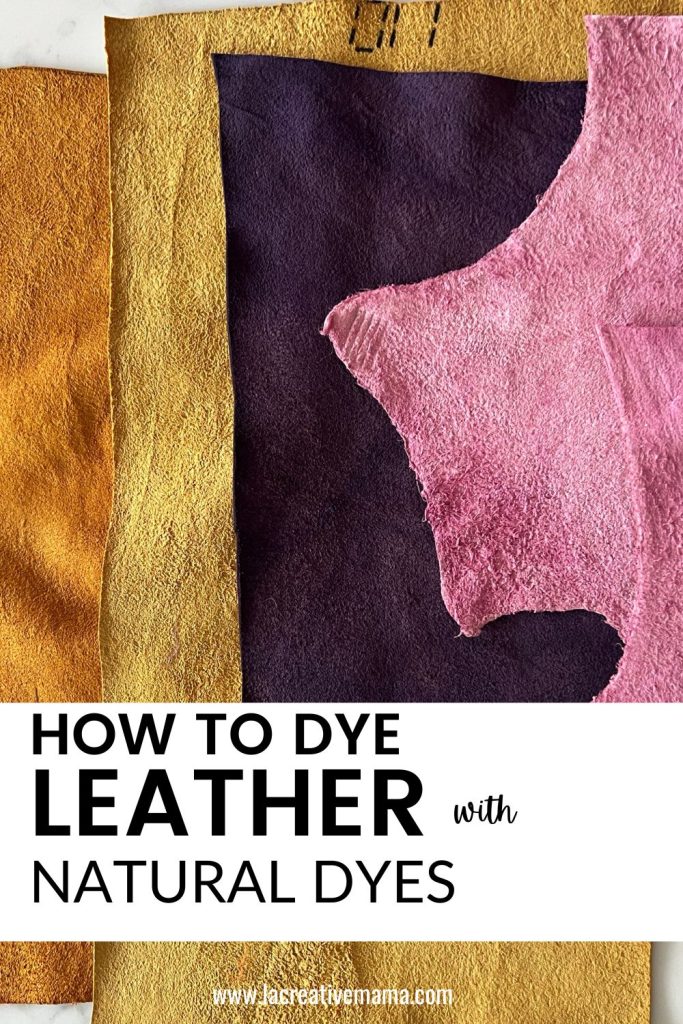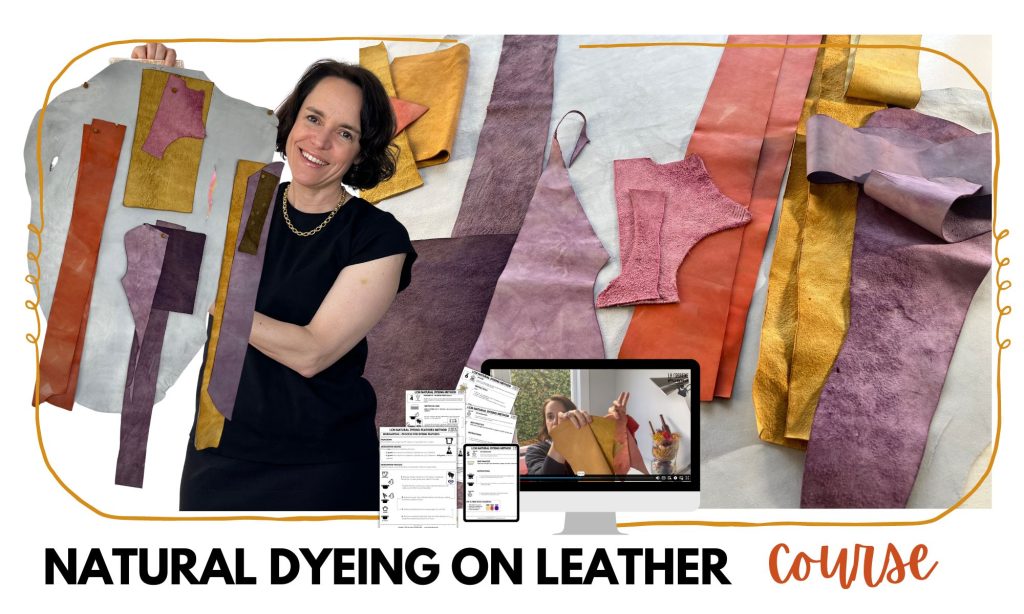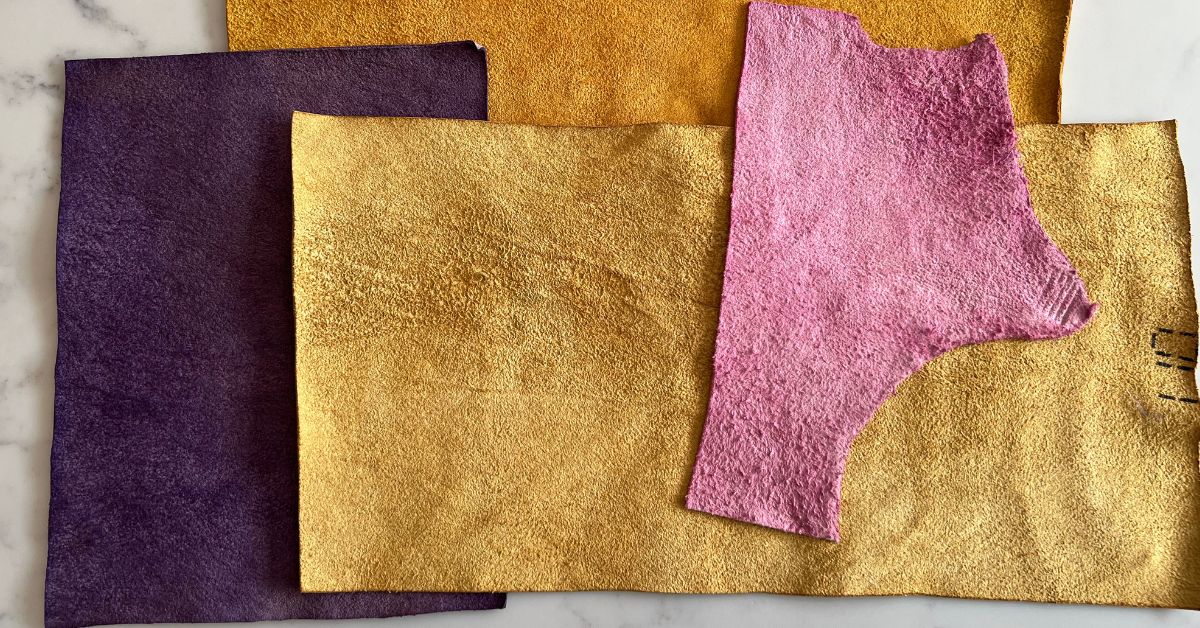Hi Creative Mamas! I am always so excited to share with you my love for natural dyeing and creating beautiful bright colors using natural dyes!
Today I want to share with you the type of color results that you can get from natural leather dyeing.

When I first started experimenting with dyeing leather material using natural dyes and processes, I quickly realized that leather needed a different dyeing process to the one I use for fabrics and yarns.
My first experiment with a leather item was pretty terrible. I started with a 10 inch by 10 inch square of leather and managed to shrink it to 3 inches by 3 inches. I also managed to change the texture from beautiful soft leather to hard and rough!
The photo below shows one of my first attempts at leather dyeing. As you can see I traced the original size of this particular uneven piece of leather and the dark purple piece is the shrunk result after the dye bath process.

Through trial and error I have learnt how to dye leather using natural dyes to create bright and lasting colors. I have found a processes and natural methods that deliver similar natural color to the ones we are getting on fabrics and yarns.
The photo below shows strips of leather next to yarn. I dyed all of them using the same natural dyes:
- Madder root (red)
- Logwood (purple)
- Onion skins (yellow)
As you can see we are getting very similar results on wool yarn and on leather.

We are getting bright pinks from cochineal, bright reds from madder root, beautiful purples from logwood and amazing yellows from onion skins, coreopsis and eucalyptus!

Dyeing leather naturally has become one of my favorite ways to bring life and personality into my leather projects.
The process isn’t just about adding color—it’s a chance to connect with the materials and work sustainably by using natural leather dyes instead of harsh chemicals.
In this post, I’ll walk you through the best natural dyes to use to dye leather and tips on getting beautiful, long-lasting results.
Best natural dyes for leather

For best results I always dye leather using these natural dyes:
- walnut husks
- coffee dye
- cochineal
- madder root
- logwood
- coreopsis
- marigolds
- onion skins
- eucalyptus
- acorns
- goldenrod
- black tea
- henna
Why I Chose Natural Dyeing Over Chemical Alternatives
When I first started working with leather, I used different types of leather dyes (alcohol-based dyes). They gave great coverage but came with a strong chemical smell and required a lot of precautions. Plus, I wanted a more sustainable option for my leather goods.
So I started using natural vegetable dyes and experimenting with ingredients like pomegranate juice, black walnuts, and even red wine. These dyes are non-toxic, more eco-friendly, and create unique colors that synthetic dyes can’t match.
Please note that I don’t use or recommend basic dyes such as pomegranate juice and red wine because they are fugitive dyes (This type of dyes are not colorfast which means that they fade away), but initially I was experimenting with different materials and wanted to see how the leather would react in terms of color saturation and color brightness.

Another reason I love using natural dyes is the natural texture and patina they add to the leather over time. The photo above shows leather which was dyed using logwood dye.
Preparing the Leather
To achieve the kind of results that I have shown you in the photos, you must always mordant your leather. But before you go through the mordanting process its a good idea to clean the leather really well.
For better results you must always work with a clean surface. Before applying any dye, you must ensure the leather surface is spotless.
Grab a clean cloth or soft cotton rag to wipe away dust, oils, or dirt. Sometimes, a little lemon juice helps open up the pores of the leather, especially if you are working with vegetable-tanned leather (often called veg-tanned leather).
If the leather isn’t clean, the dye might settle unevenly, and no one wants to waste all that effort on a patchy result.
For better dye absorption, moisten the leather slightly with a damp cloth or spray bottle.
If you are working with unfinished leather or top grain leather, a light soak ensures the dye gets absorbed deeply into the material.
Types of leather
The first thing to consider before we get any further is what kind of leather to get.
The main thing is to get hold of 100% real natural leather and to do your due diligence to make sure you are purchasing from reputable and cruelty free suppliers.
So you can also ask questions at the time of purchasing your leathers and you will be able to asses if you feel comfortable working with those suppliers.
Types of leathers which are great to work with include:
- Cow leather
- Sheep leather
- Goat
- Pig
- Kangaroo
- Deer
Working with leather – Tanning processes
There are currently two ways in which leather is processed:
- Vegetable tanned leather
- Chrome tanned leather
Let me start by saying that none of these processes is ideal, they both have their pros and cons for people like us who want to use leather as part of our sustainable and creative home and studio based crafts.
Chrome tanning is a method whereby chromium sulphate is used to preserve animal skins and prevent rot. This process produces a soft and very strong leather with many benefits and some drawbacks.
Chrome tanned leather production creates toxic waste and the water used in this process needs to be treated appropriately before releasing into the environment. This is not an issue when it comes to leather which has been treated in first world countries since the tanneries are certified and follow strict regulatory protocols, however, it’s a real problem in less developed countries.
On the other hand, vegetable tanned leather uses natural tannins found in the bark of various tree species to bind to the collagen fibers in the hide. This prevents the leather from rotting and preserves it for use.
This type of tanned leather is much better for the environment but it’s so hard to dye and print using natural methods as the ones I teach.
It’s a super hard leather, very tough to work with unless you have specialized leather tools and it’s impossible to run it through a domestic sewing machine.
Conditioning Dyed Leather
One of the best methods I’ve found to keep my dyed leather soft and durable is to use oils like olive oil or neatsfoot oil. After the leather is completely dry, I rub in a small amount of oil to prevent it from becoming stiff.
Jojoba oil also works well, especially if you’re looking for a light, non-greasy finish.
Applying a conditioner isn’t just about softness—it also creates a protective barrier that helps the dye last longer. For extra protection, I sometimes use Aussie Leather Conditioner, which is great for preserving both color and texture.
Tips for dyeing leather
Natural leather dyeing can be unpredictable, but that’s part of the charm. Still, here are some issues I’ve faced and how I’ve solved them:
– Uneven Color: This usually happens if I skip prepping the leather properly. A patch test on a scrap piece is a good idea to avoid surprises.
– Fading Over Time: As long as you prepare the leather correctly which means cleaning and mordanting before dye bath, then you should avoid any fading. Conditioning regularly also prevents fading.
– Unexpected Results: Sometimes the chemical reaction between the leather and dye produces surprising colors. With iron- modified dyes, for example, you can get darker shades than you’d expect.
Check out the type of color modification that is possible by using an iron solution post dye bath, the photos below show examples of cochineal dye (pink) and onion skins (yellow) modified with iron.


Check out our own Natural Dyeing on Leather Course, this is an extension of The Natural Dyeing ULTIMATE Course, but you must have an understanding of how La Creative Mama Natural Dyeing Method works to get the most out of it!

Natural leather dyeing is more than just a process—it’s a creative journey. It’s about experimenting with different shades, finding what works, and enjoying the craft. Whether you’re after bold colors or subtle earthy tones, natural dyes offer endless possibilities for your leather products.
So, gather your ingredients, patch test on a scrap piece, and dive in!

And trust me, there’s nothing quite like seeing your hard work come to life in the form of high-quality, eco-friendly leather goods!

